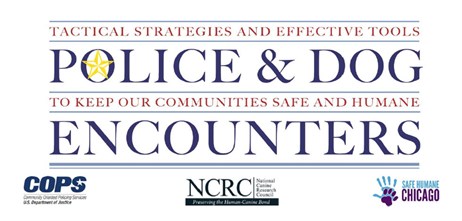Police and Dog Encounters: Tactical Strategies and Effective Tools to Keep Our Communities Safe and Humane
 Most humans love dogs. In the United States alone there are more than 70 million dogs, roughly one for every four people. Almost 40 percent of U.S. households have at least one dog in them, and an ever-increasing percentage of dog owners consider their dog to be a member of the family. Because dogs are so much a part of U.S. society, law enforcement officers routinely deal with them in the line of duty, and not just when responding to calls about inhumane treatment or animal abuse, or when dogs are seen to present a danger to the public. Officers encounter dogs in the course of almost every kind of police interaction with the public, from making traffic stops and serving warrants to interviewing suspects and witnesses, and even pursuing suspects.
Most humans love dogs. In the United States alone there are more than 70 million dogs, roughly one for every four people. Almost 40 percent of U.S. households have at least one dog in them, and an ever-increasing percentage of dog owners consider their dog to be a member of the family. Because dogs are so much a part of U.S. society, law enforcement officers routinely deal with them in the line of duty, and not just when responding to calls about inhumane treatment or animal abuse, or when dogs are seen to present a danger to the public. Officers encounter dogs in the course of almost every kind of police interaction with the public, from making traffic stops and serving warrants to interviewing suspects and witnesses, and even pursuing suspects.
A problem-solving policing approach to dog-related incidents and encounters should recognize the extent and complexity of the human-canine relationship; the need for education concerning the human-animal bond and its well-documented benefits; and the need to regulate reckless and inhumane owner behavior in order to encourage public awareness of risk factors as well as to address human- and animal-behavior problems within the context of applicable statutes, rules, and regulations. The goal is safe, humane communities.
Through proper training, law enforcement officers not directly tasked with enforcement of animal-related statutes and ordinances can still be prepared for safe, non-confrontational encounters. In addition, with training in effective responses to genuinely volatile situations, officers can successfully avoid the worst-case scenarios—being injured by a dog or shooting one. But not every police or sheriff’s department can afford the resources needed to train their officers effectively for successful encounters with dogs.
In August 2011 the COPS Office released The Problem of Dog-Related Incidents and Encounters. This manual was developed under the auspices of the University of Illinois’ Center for Public Safety and Justice by authors from the university, the Best Friends Animal Society, Safe Humane Chicago, and the National Canine Research Council (NCRC). The entire project was funded by the NCRC.
Because of the popularity of the printed book, and because high-profile incidents may receive regional and even national media attention, the NCRC and Safe Humane Chicago considered how they might make information adapted from the manual available in other media. In partnership with the COPS Office, the NCRC and Safe Humane Chicago decided to launch a video training series for law enforcement agencies across the country. Called Police & Dog Encounters: Tactical Strategies and Effective Tools to Keep Our Communities Safe and Humane, the videos give on-duty police the tools to keep them protected when they encounter a dog.
“Police are the cornerstone of every community across the country, and these brave men and women keep us safe. They are trained and prepared for dangerous and unfamiliar situations. But part of their training was incomplete—until now,” said Stacey Coleman, Executive Director of the NCRC and executive producer/funder for the series.
Narrated by retired Chicago police superintendent Terry Hillard, the videos feature dog behavior expert Brian Kilcommons demonstrating real-life scenarios with SWAT and street officers. By facilitating interactions between real dogs and police officers, Kilcommons teaches officers how to better understand canine body language and how to better monitor their own body language to make dogs feel more at ease. The series is made up of five videos, each 10 minutes in length:
- Video 1, An Overview: Assessing the Situation
- Video 2, Communicating with Dogs: Police and Dog Body Language
- Video 3, Tactical Considerations
- Video 4, Use of Force Considerations
- Video 5, Legal Considerations: Liability, Reporting, and Documentation
“The goal is to introduce options and strategies that will deescalate encounters with dogs, not to make police into dog experts,” said Cynthia Bathurst, Executive Director of Safe Humane and content producer for the series. “With police perspective as our guide, we have included advice from experts on how to manage risk and liability and how to accurately write reports about encounters with dogs. When officers have more information and more options available to them, they can better protect themselves, citizens, and dogs.”
 The videos are the first law enforcement training resource of their kind in addressing risk management, canine body language, officer safety, and canine safety. There is also a companion booklet, “The Problem of Dog-Related Incidents and Encounters,” that has supplemental information to the videos. It can be downloaded through following this link: http://ric-zai-inc.com/ric.php?page=detail&id=COPS-P206.
The videos are the first law enforcement training resource of their kind in addressing risk management, canine body language, officer safety, and canine safety. There is also a companion booklet, “The Problem of Dog-Related Incidents and Encounters,” that has supplemental information to the videos. It can be downloaded through following this link: http://ric-zai-inc.com/ric.php?page=detail&id=COPS-P206.
Donald Cleary, Director of Communications and Publications
National Canine Research Council
In collaboration with Melissa Bradley, COPS Office
Enhancing Survivability at Mass Casualty Events | Coffee with a Cop | Police and Dog Encounters | Militarization | Innovative Policing on a College Campus: UMASS
